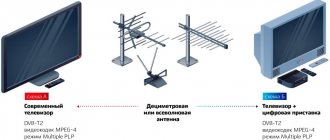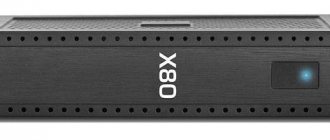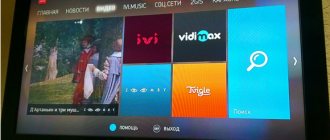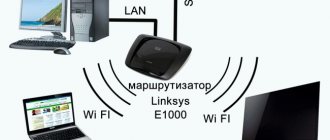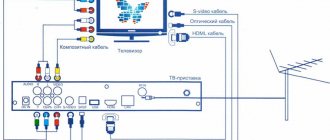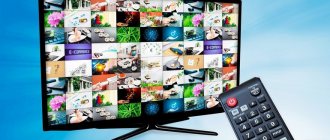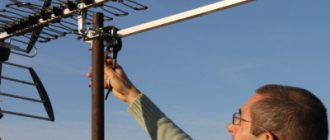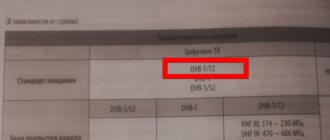Starting from 2021, broadcasting of analogue television signals in Russia will completely cease, and 20 television channels will be broadcast free of charge from the transmission tower in digital format.
When switching to digital broadcasting, nothing will change from a technical point of view for signal reception. The old UHF antenna and cabling in the apartment will continue to serve.
But due to the fact that the digital terrestrial signal uses video signal encoding according to the new DVB-T2 standard, owners of old TVs will have to buy a new TV or purchase a digital receiver (set-top box). The state has taken care of pensioners and the costs of purchasing the set-top box will be compensated for them.
It should be noted that nothing will change for cable television, since service providers broadcast both analog and digital signals. Therefore, in connection with the transition to a new broadcasting standard, there is no need to take action. But over time, cable television will also be transferred to the DVB-T2 standard.
Advantages of digital television
Compared to analog television, digital technology benefits from a longer list of advantages, significantly expanding the capabilities of TV users. The main advantages of digital television:
- improved sound and picture quality;
- expansion of the number of channels in the same range;
- the ability to record television programs and create archives;
- no need for powerful transmitters;
- choice of broadcast language and subtitles;
- the ability to add a radio to the multiplex;
- ability to receive EPG signals.
Digital television has very few disadvantages:
- During a thunderstorm and other adverse weather conditions, the signal may be poorly transmitted;
- if the signal weakens (often this depends on the choice of antenna), individual fragments of the image or the entire picture as a whole partially freeze.
The main differences between analogue and digital broadcasting
A feature of an analog signal is its continuity over time. It is transmitted on radio frequencies from broadcast stations. The second feature is that one channel occupies entirely one frequency. Such signals are easily subject to physical interference and depend on:
- Geomagnetic field.
- Climatic conditions.
- Landscape conditions.
- Remoteness of the TV tower.
- Weather phenomena.
All this negatively affects the quality of the final image.
Digital television broadcasting differs in the method of transmission. All outgoing information is pre-encoded in binary code. Then it is transmitted in this form to the receiver, decoded and displayed on the tap. With this transmission method, a whole pool of TV channels can be transmitted on one frequency and at the same time maintain excellent picture and sound. The advantages of setting up digital television include:
- High quality video and sound.
- Resistance to interference.
- Watch more TV channels.
- The ability to stop and record your favorite TV show.
The volume of one pool of TV channels transmitted by the provider is called a multiplex. It is assumed that Russians will be able to use 2 multiplexes of free channels.
What you need to connect digital television - necessary equipment
To watch digital channels, you need to buy a TV that supports DVB-T2, or buy additional equipment for a regular device. You will need a high-quality cable, a digital television receiver and an antenna capable of operating in the UHF range.
Free installation of DVB-T2 digital television:
Choosing an antenna
Any home antenna can receive a digital signal. For residents of high-rise buildings, the best option would be to install a common antenna (CETV) for the entire house.
For private sector residents there are the following options:
- a satellite antenna for signal reception is a reliable option that works regardless of the proximity of the tower, terrain and weather conditions;
- internal antenna - a standard model, suitable if the television tower is located close to it;
- standard outdoor antenna - if the signal is not too strong, the TV tower is located far away or the terrain makes it difficult to receive the signal;
- cable television – expands the package of available channels;
- IPTV – makes it possible to simultaneously use all the advantages of digital television in combination with Internet access.
TV
An antenna alone is not enough - the TV must be able to receive a digital signal. For owners of modern equipment that was released over the past 3 years, there is no need to purchase additional equipment. Manufacturers have provided the ability to connect digital television without using a set-top box/receiver, so modern models come with built-in equipment for receiving such a signal.
When purchasing a new TV, you need to make sure that the model you choose supports digital standards. The specifications must include DVB-T2.
Console
If you are using a TV that does not support DVB-T2, you must additionally purchase a receiver - a set-top box that connects to the TV and allows you to receive a digital signal. The assortment of TV equipment stores includes set-top boxes that differ in their functionality:
- SMART set-top box is an addition to the TV for receiving digital signals and the Internet. Expands functionality - the TV can also be used as a computer.
- Set-top boxes for satellite dishes - equipped with a powerful processor and additional inputs.
- Hybrid receivers – allow you to receive satellite and cable signals.
- Terrestrial broadcast receivers - work in conjunction with standard antennas.
- Set-top boxes with a built-in card reader - for using cards purchased from the provider.
- Receiver with CAM slot . Such equipment can be easily reprogrammed, so there is no need to worry that it will become outdated and will not be able to receive a signal.
- Combined receivers . They are equipped with a card reader, have a CAM slot and are capable of receiving FTA channels. Such devices can work with standard multiplexes, as well as with encrypted channels. It is enough to enable automatic key updating in the settings menu or enter them manually using the remote control.
- Receivers equipped with a conditional access system . This is a hardware and software complex that is used to gain access to a number of encrypted channels that are not available in standard multiplexes.
It is worth paying attention to the functionality of the console and its additional capabilities. The best option is a SMART receiver, which will significantly expand the capabilities of even the simplest TV.
When purchasing a digital receiver, you must check with the seller about the possibility of returning or exchanging the product within 14 days. This is necessary even if the device was checked in the store and turned out to be fully functional. It is possible that when you connect the set-top box at home, it will not receive the signal from the antenna well enough - in this case, you will need to choose a more suitable model.
Cable
When choosing a set-top box for your TV, you need to pay attention to the cable included. In some cases, you may need to purchase an adapter if it is impossible to connect the included cable to the TV.
Propagation of television radio signal in the UHF range
Digital broadcasting in Russia from multiplexes is carried out in the decimeter range (UHF) at frequencies from 474 to 858 MHz. In each region, to eliminate the mutual influence of television transmitters, two frequencies are allocated.
The distance to the tower at which stable reception is possible depends on the transmitter power. Under normal conditions, the multiplex transmitter with a power of 1 kW provides reception at a line-of-sight distance of the tower up to 40 km. But if it rains or there is high solar activity, then this distance is significantly reduced.
For stable reception of a digital signal over the air, the receiving antenna must be in the line of sight of the transmitter antenna installed on the tower.
In urban environments, the path of the radio signal is often blocked by multi-storey buildings, power lines and other obstacles. Therefore, at a distance of even several kilometers, if the TV is successfully configured, the sound may periodically disappear or the image may crumble into colored squares or disappear.
If the electromagnetic signal has high power, then part of it can be reflected from neighboring buildings and it is often possible to tune the TV to receive channels thanks to the reflected signal. In this case, the antenna turns out to be directed in a completely different direction from the TV tower.
How to set up digital television reception and connect digital channels
Once all the equipment has been purchased, you can begin the installation process. If you follow the instructions, you can install and configure digital television reception yourself.
How to connect digital television and set up terrestrial digital channels:
Connecting DTTV on a TV with DVB-T2 support: step-by-step instructions
You can set up digital television reception on a TV with built-in DVB-T2 support as follows:
- Unplug the TV.
- Find an input for connecting digital television and connect an antenna to it.
- Turn on the TV and find the settings section.
- Select TV setup mode.
- In the menu that opens, you need to find DVB-T2 or tuner mode, check these boxes and save the settings.
- Specify the country, and also enable channel search mode.
- Select DTV to receive all available terrestrial digital channels.
Automatic configuration is also possible using the following algorithm:
- Connect the device to the antenna and network.
- On the TV control panel, find the DVB settings button.
- Select automatic installation in the settings.
- Wait for the channels to be installed and configured.
Automatic installation of digital television reception takes up to 10 minutes, after which you can start viewing all available channels.
The algorithm for setting up the reception of digital channels may differ depending on the manufacturer and model of the TV. If the device cannot be configured using the described technology, you should read the instructions for it.
How to connect digital television without a set-top box:
Receiving a digital television signal using a set-top box on analog and digital TVs
If the TV does not support DVB-T2, you must first connect the receiver and then start setting up. The step-by-step instructions in this case look like this:
- Remove the receiver from the original packaging and be sure to remove the protective film so that the device does not overheat.
- Using an RCA or HDMI cable, connect the set-top box to the TV.
- Connect an antenna to the receiver.
- Turn on the TV and go to the settings section.
- Select country.
- Select the signal standard: instead of DVB-T (analog) – DVB-T2 (digital).
- In the menu that opens, select automatic setup and wait for the process to complete.
- Save settings.
For older TVs that only have an antenna input, you can use receivers with an RF modulator. Such set-top boxes are connected directly to the antenna input, and they are capable of operating in the UHF range.
If you select DVB-T and DVB-T2 during setup, the TV will simultaneously receive analogue terrestrial and digital channels.
Watch instructions for connecting digital TV using the receiver in this video:
Receiving digital television on a computer
It is possible to connect digital television on a PC or laptop, but for this you need to purchase additional equipment - a digital USB tuner. Connection and setup instructions:
- Connect a selected digital tuner via the USB input.
- Run the new device detection program.
- Install software for the receiver to work correctly.
- Wait for the channels to scan and start watching.
Connecting digital channels for viewing on a computer should only be done if the device meets the technical requirements set by the manufacturers of USB receivers.
Rating of the TOP 17 best set-top boxes for digital TV
| TOP 17 best set-top boxes for digital TV 2021 | ||
| 1 | Apple TV 4K | Find out the price |
| 2 | Selenga T81D | Find out the price |
| 3 | Oriel 421 (DVB-T2/C) | Find out the price |
| 4 | HARPER HDT2-5010 | Find out the price |
| 5 | World Vision T62A | Find out the price |
| 6 | D-COLOR DC1301HD | Find out the price |
| 7 | Lumax DV-1110HD | Find out the price |
| 8 | IconBIT Movie T2 | Find out the price |
| 9 | Lumax DV 1108HD | Find out the price |
| 10 | D Color DC1002HD mini | Find out the price |
| 11 | BBK SMP240HDT2 | Find out the price |
| 12 | NVIDIA SHIELD Android TV | Find out the price |
| 13 | SIGNAL ELECTRONICS HD-300 | Find out the price |
| 14 | LEXAND LTV 300 | Find out the price |
| 15 | A95X F3 | Find out the price |
| 16 | AVerMedia Technologies AVerTV Hybrid Volar T2 | Find out the price |
| 17 | Digifors SMART 200 Android | Find out the price |
Errors and problems when connecting digital television
Digital technology is more complex, so it is not always possible to connect it the first time and get everything to work. There are a number of common mistakes when setting up digital television reception that you can deal with yourself.
Outdated receiver firmware
The receiver cannot operate without suitable software. If the firmware is outdated or was initially installed incorrectly, the following problems may occur:
- digital television setup error;
- some channels do not work;
- the TV does not receive the signal well;
- poor image quality.
To flash the receiver firmware, it is not necessary to take the device to a service center. If the set-top box included an installation disk with software, you need to connect via a USB cable and start installing the firmware.
If the kit does not include an installation disk, the problem can also be solved. Having basic skills in working with technology, you can reinstall the software yourself using this algorithm.
- Find the official website of the manufacturer that released the console.
- In the software section, find the model name of the receiver that needs to be flashed.
- Download the archive with the software to your computer and unpack it into a separate folder.
- Send the folder with the contents to a removable USB drive.
- On the manufacturer's website, find step-by-step instructions for installing software for the selected model.
- Connect the media to the set-top box and install.
Manufacturers offer firmware downloads completely free of charge. If it requires registration, payment or sending an SMS, it is most likely a scam site.
Antenna problems
If the antenna does not receive a signal the first time it is connected, there is no need to immediately run to the store and ask for it to be replaced. It is worth checking the following nuances:
- correct connection;
- frequency on the interactive map of CETV;
- serviceability of the cable and contacts.
If no problems are found, most likely the wrong antenna type was selected. If the antenna is not powerful enough to receive a high-quality signal, purchasing and installing an amplifier can help. You can also look for a more suitable type of receiving device.
If the problem cannot be solved on your own, you should contact a specialist. Perhaps the problem lies in the equipment that simply needs to be replaced or repaired under warranty.
Troubles at the TV station
In 80% of cases, problems with digital TV reception are caused by malfunctions in the user's equipment or errors made during the installation process. But there are situations when there is no point in looking for a breakdown or errors in the settings.
Since the complete transition to digital television has not yet occurred in all regions, failures often occur directly at the station. Prevention is also carried out periodically; during such periods, digital channels are also unavailable.
If there is a problem with the image or access to packet digital channels, but all equipment and settings are in order, you should call the provider’s hotline. Companies providing digital television connection services constantly inform about planned maintenance or other causes of failures, but in the event of unforeseen breakdowns, it is impossible to notify subscribers in advance.
I want to know whether my television is analogue or digital?
Turn on the main central channels - Channel One, Rossiya 1, NTV, Channel Five, REN-TV, STS, TNT, Zvezda, TVC and others.
If you see the letter “A” next to the logos, then you have an analogue television, and you need to do a number of steps so that your TV can receive a digital signal.
If there is no "A" next to the logo, after April 15 you will be able to continue watching TV as before. The absence of the letter "A" means that :
- you initially have digital television (satellite or Internet TV);
- you have terrestrial television, but the transition to digital broadcasting has already been completed;
- Do you have cable TV? Moscow authorities have agreed with cable television operators to preserve analogue broadcasting on cable. But if you want, you can also switch to digital broadcasting in cable.
Please note : if you have multiple TVs in your home, they may receive TV signals in different ways. For example, in the living room the TV is connected to cable TV, and in the kitchen the reception is via an antenna.
Questions and answers
During the process of installing equipment and setting up digital television, various questions may arise that are not covered in the instructions or subscriber’s memo.
How many digital channels will be available?
It all depends on the package and country of connection. There are 2 multiplexes available in Russia - 20 basic channels. In Ukraine there are 32 channels. If you connect through a provider, package channels will be available - from 50 or more, but a monthly subscription fee will be required.
Why did the message “no signal” appear on the screen?
If everything worked before, there could be two reasons - a broken cable plug or a bad signal due to maintenance work at the television station.
Why are not all channels displayed?
The standard terrestrial digital television package includes a limited number of channels. If a channel that is part of the connected multiplexes is not displayed, you need to check the signal level - there may be problems with the antenna.
Can I receive cable and digital channels at the same time?
Yes, this is possible, but this will require the additional use of a television signal adder. Such adders are usually sold in television equipment stores.
Why do channels freeze?
If during viewing the image on the screen begins to freeze or decompose into pixels, there is only one reason - signal deterioration due to a malfunction of the antenna or bad weather conditions. If you purchase a satellite dish, you don't have to depend on the weather.
Knowing the basic information on connecting and setting up digital television reception, you can independently make the transition to it from analogue technologies. If for some reason you cannot install the software or configure channels, it is better to contact a service center and entrust the task of switching to digital television to professionals.
5 / 5 ( 4 voices)
Changing provider to MTS
Relatively recently, the MTS company began broadcasting television channels from the ABS2 satellite, so there are no reliable reviews about the quality of the equipment and signal stability yet. But we can easily say that MTS has the most advantageous offer on the satellite systems market.
Provided that we already have tricolor TV, for the transition we will need an official MTS receiver and a linear converter. Since the satellites of both providers are different, we will need to re-align the satellite dish to the 75 degree satellite. You can read more about how to do this here.
Do I need to connect the set-top box to a common device?
If the user lives in an apartment and a public antenna is installed on the roof, then you can try to connect to it. But it is worth remembering that most of the devices were installed back in Soviet times. Such antennas have not been repaired for a long time. In practice, it has been shown that such equipment can only receive signals in decimeter waves.
Is it worth buying it and how to retune the TV?
All people who do not have Smart TV or satellite television will have to buy set-top boxes. It is also worth considering the advantages and disadvantages of this device. You should not purchase a digital set-top box if :
- The viewer has a modern LCD TV.
- Does not accept small buttons and multiple remote controls (applies to older people).
- Residents have already chosen pay TV from Internet providers.
- Subscribers who have installed satellite dishes.
To opt out of a shared antenna, you need to find out which organization provides the service. The contract between the operator and the subscriber can be terminated at any time , but only if there are no debts.
You can find out who maintains the collective antenna from the management company or homeowners association. There is also an option to contact the Unified Settlement Center.
- First of all, you need to find out who is servicing the device.
- Call the company or go to the official website to find out how to apply for a waiver.
- Submit an application at the operator’s office or through your personal account. In some cities this can be done through the MFC.
- Wait for a worker to come and disconnect the apartment from the antenna.
Description, pros and cons of a collective device for receiving TV
A collective antenna is a device where the signal is distributed to a large number of subscribers. A collective antenna is installed in every residential building.
The main task is to provide the residents of the house with television channels. You must pay monthly for such an antenna. Different regions have their own prices.
This antenna consists of the following parts:
- Receiver _ A device that helps receive digital numbers.
- Amplifier . It allows you to amplify the system signal.
- Distribution system . This is a device with which television is tuned.
There are some advantages of this device:
- Free service feature. The housing company is responsible for repairs and installation of the antenna.
- Good quality. Antenna installation is carried out by specialists, not by residents of the house. They calculate the location of the area and select the optimal point for installation.
- You can set up TV broadcasting immediately after moving into your home. No additional equipment is required.
- Customers can simultaneously set up analogue and digital television broadcasting.
As for the negative aspects, there is only one - a monthly subscription fee for use. It has already been included in utility bills.
